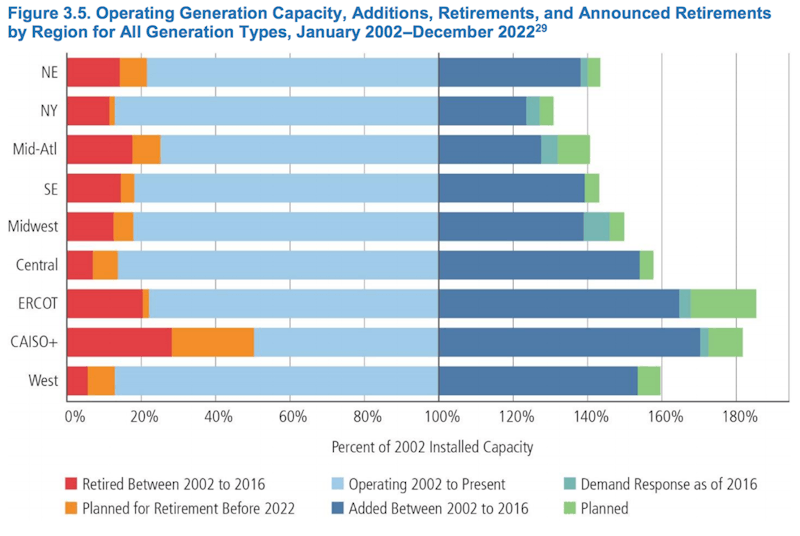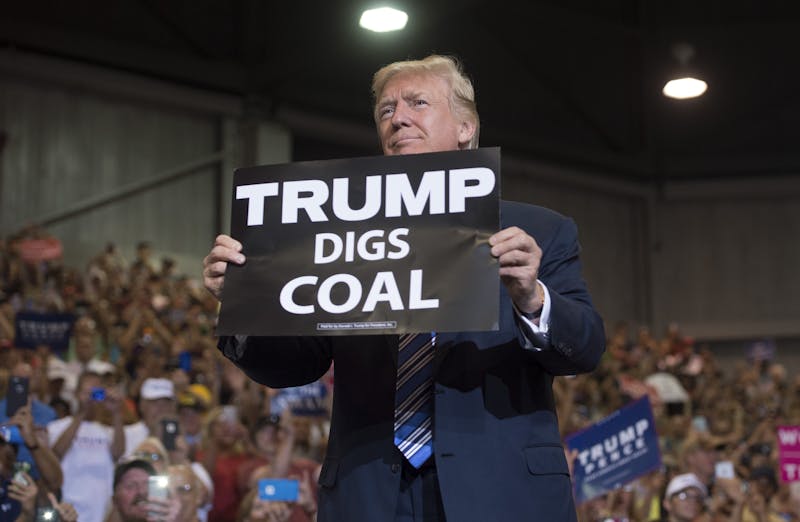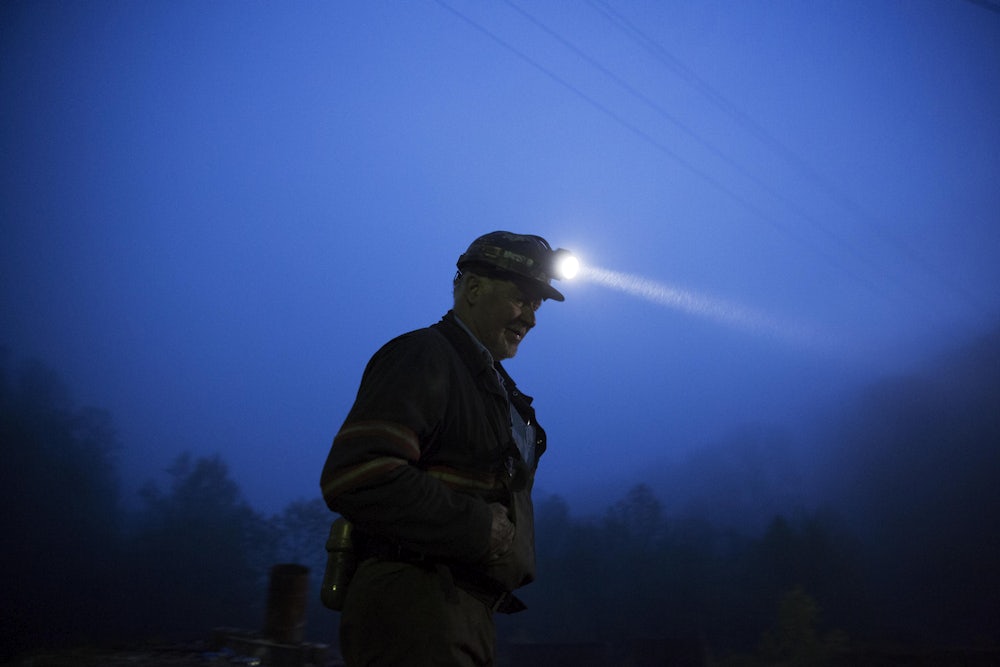Coal. Guns. Freedom.
I saw these three words on a little sticker affixed, discordantly, to the window of a car in a small Colorado town. It struck me as funny at first: Coal and guns being elevated to the status of platonic ideals or, even more loftily, the refrain of a bad country song. All it was missing was Jesus, beer and Wrangler butts. A few days later, though, as I sat on a desert promontory overlooking northwestern New Mexico, the sticker didn’t seem so funny. As the sunrise spilled across sagebrush plains and irrigated cornfields, it also illuminated a narrow band of yellow-brown clouds on the horizon.
The clouds were smog, a soup of sulfur dioxide, particulates, nitrogen oxide and other pollutants emanating from the smokestacks of the coal-burning Four Corners Power Plant and San Juan Generating Station, on either side of the San Juan River Valley. The people of the Four Corners have experienced that cloud in one form or another nearly every day for the past half century. Our skies have been sullied, as have our lungs; mercury wafts from these and other smokestacks and falls with rain on Mesa Verde National Park and in the clear, icy streams of the San Juan Mountains. The plants suck millions of gallons of water from the river each day for steam production and cooling, and they leave behind mountains of ash, clinkers and sludge, tainted with mercury, arsenic, selenium and other toxic material. That’s all in addition to the tens of millions of tons of climate-altering carbon dioxide the stacks release each year.
We’ve been told that this is just the price we pay for power, that this is what it costs to keep the lights on in Phoenix, Las Vegas, Los Angeles, that we have no choice but to live with it. To stop burning coal, or even try to mitigate the harm, we’ve been told, will put thousands of hard-working Americans out of a job, skyrocket electricity costs, and black-out our lights and computers.
Coal. Guns. Freedom.
Now, however, as many of the biggest coal plants near the end of their lives, coal-fired electricity is going the way of the steam locomotive and manual typewriter. It’s becoming clear that King Coal was a big lie, a long-standing myth. For decades, we’ve been hoodwinked by the fetishization of coal, to the detriment of us all.
Coal fueled the white invasion of the West. It stoked smelters, powered locomotives and generated steam, driving mills that processed tons and tons of rock. Newcomers heated their homes and cooked with coal, thousands of them toiling in mines to keep the fires going. The coal industry rose up on those miners’ backs, reaping enormous profits that lined politicians’ pockets. These lawmakers returned the favor by keeping regulations minimal and royalties low on federal mineral reserves, and by sending in troops to murder striking miners. “Coal is the fuel of the present,” crowed the author of a 1906 US Geological Survey report, “and so far as can be seen, will continue to lead … for a long time to come.”
Yet even then, Westerners were slowly shifting away from the expensive, dirty and inconvenient fuel. The electricity that powered the mines and towns was, by and large, generated from falling water. And when the pipelined bounty of the 1920s’ natural gas boom spread from New Mexico and Texas across the West, homeowners switched en masse to gas for cooking and heating, saying goodbye to stokers, clinkers and coal’s pervasive, greasy film.
By 1950, coal provided a mere 10 percent of the West’s electricity. Natural gas generation was eating into that slice, and plans for a network of dams along the Colorado River threatened to flood the grid with even more cheap, coal-displacing hydropower. Steam locomotives went the way of the dinosaurs, driven to extinction by diesel. American coal consumption fell by 20 percent in the 1950s alone; in the West it plummeted by 40 percent.
Facing an existential crisis, the coal industry executives knew they could not compete based on the merits of their fuel. Instead, they set out to imbue it with symbolism and mythology. Coal was not just coal, the lobbyists argued. It was abundant, reliable and deserving of a seat in the pantheon of American culture, alongside cowboys, guns — and, yes, freedom. (They also managed to convince the Sierra Club that coal plants were a green alternative to river-ruining dams.)
Most of all, coal was equated with honest jobs for hard-working miners (and voters) — never mind that mechanization and efficiency had been killing off mining jobs since the early 1900s. The shift from coal to diesel and natural gas was framed not as mere consumer choice between commodities, but as an attack on some ineffable American value.
Coal. Guns. Freedom.
The industry enlisted Sen. Wayne Aspinall, a Democrat from the coal state of Colorado, to its cause, and Congress created the Office of Coal Research in 1960 “to encourage and stimulate the production of coal in the United States through research and development … and maximize the contribution of coal to the overall energy market.” Lawmakers from coal-producing counties and states ganged up on other forms of energy, taxing natural gas, for example, or requiring public institutions to heat with coal, free market be damned.
In 1952, the U.S. Bureau of Reclamation released its “Study of Future Power Transmission for the West.” It revealed the perverse logic that prevailed at the time: Since both the population and per capita electricity use were rapidly increasing, new power plants were needed. The new power supplies would lower electricity prices, thus drawing more people and encouraging more consumption, which would then spur the building of more power plants, and so on. It was a recipe for a slow-building disaster, regardless of what fueled the power plants. Pushing coal as the main ingredient made it that much more catastrophic.
The authors of the report acknowledged that natural gas was relatively cheap and clean, easy to transport and abundant. Nevertheless, they recommended coal to power the massive fleet of new plants, because they worried that natural gas supplies might someday run short. In so doing, they signaled that the federal government, far from being “fuel neutral,” had a strong preference for coal. The mythology around coal became policy.
Starting in the mid-1960s, coal plants were built across the nation at a rapid rate, with more than 10,000 megawatts of coal-generated capacity — the equivalent of about five Four Corners power plants — added annually. Smoke-belching plants rose up from the deserts of Utah, Arizona and New Mexico, including several on or near the Navajo Nation, sending their juice to the air conditioners, televisions and “electrified homes” of Los Angeles, Phoenix and Las Vegas. Monstrous draglines gouged into spare mesas, and smog settled over valleys and obscured mesa and mountain views. Each of the new plants emitted at least 10 million tons of greenhouse gases annually.
The coal frenzy was not dampened by the passage of the Clean Air Act of 1970 — it took years to implement the law, and even longer to enforce it. In 1977, Congress strengthened the act in ways that would give cleaner-burning natural gas a leg up. But that was nullified by another law, the Powerplant and Industrial Fuel Use Act of 1978, which prohibited the use of natural gas as a primary fuel for generating electricity. It was a blatant act of market interference, in which the government chose coal over cleaner-burning natural gas. Lawmakers and lobbyists argued the law would help the U.S. achieve energy independence, but that was yet another myth. All it really did was double down on coal, thus tightening a stranglehold on the nation’s grid that would take decades to loosen.
This April, in a move that harkens back to the 1950s, Energy Secretary Rick Perry launched a review of the electrical grid, clearly looking to kill regulations and otherwise prop up the flagging coal industry. Perry presumed that reliable and “critical baseload resources,” such as coal-power, were being unfairly bullied off the grid by “regulatory burdens” and “the market-distorting effects of federal subsidies that boost one form of energy at the expense of others.” Meanwhile, long before the review was complete, the Trump administration went about killing environmental protections aimed at keeping harmful pollutants out of the air, rescinded an initiative to get corporations to pay their fair share for mining coal owned by U.S. taxpayers, and halted a study of the effects of mountaintop mining — all in the name of reliability, affordability and, of course, jobs.
It must have been a shock, therefore, when Perry’s own experts concluded in August that government interference isn’t killing coal; the free market is. “The biggest contributor to coal and nuclear plant retirements has been the advantaged economics of natural gas-fired generation,” the study’s authors wrote, essentially repeating common knowledge. Furthermore, coal’s phase-out and the increase in renewable energy on the grid have not hurt reliability or, for that matter, caused a net loss in jobs.
The findings were of little surprise to industry watchers. Coal’s foreseeable decline began when Congress repealed the Fuel Use Act in 1987. That opened the way for a huge buildup of natural gas-generated capacity. When the shale drilling revolution glutted the market with natural gas beginning in 2008, an abundance of power plants were already on hand to put it to use. The Great Recession caused electricity demand to plateau at about the same time, and the combination of factors caused wholesale electricity prices to fall. The myth of coal as the most affordable fuel perished, though its greater symbolism has proven more stubborn.
The buildup of wind and solar power further decreased overall electricity prices in relation to coal. Playing a minor role in coal’s misfortune were “a suite of environmental regulations” — from the Clean Power Plan to the Mercury and Air Toxics Standard — that, Perry’s review says, “had varying degrees of effects on the cost of generation.” While these rules do affect coal more than other fuels, they aren’t “unfairly” targeting coal, as the industry and its boosters contend. Rather, they target air pollution, and coal happens to be the most polluting fuel currently in use. Other Obama-era regulations are harder on natural gas — both the Environmental Protection Agency and Bureau of Land Management’s methane rules targeted oil and gas production, leaving methane-venting coal mines alone.
Between 2002 and 2016, some 59,000 megawatts of coal-generated capacity were taken off the grid nationwide due to plant retirements. Salt River Project announced it would shut down its Navajo Generating Station in 2019 because the plant no longer made economic sense. Colstrip in Montana is slated to go dark in 2027, and Intermountain Power Project in Utah will close in 2025. Public Service Company of New Mexico wants to phase coal out altogether over the next 15 years, which includes shutting down San Juan Generating Station in 2022 and divesting from Four Corners Power Plant. It won’t be an easy task, since the utility currently gets 54 percent of its electricity from coal, but PNM analysts insist that more efficiency and a switch to natural gas, nuclear and renewables will cost their ratepayers less in the long-run.

Even the coal plants that continue to run are seeing less use, and different uses, causing coal to lose ground. The Navajo Generating Station put out 30 percent less power in 2015 than it did two years earlier, for example, so if it weren’t scheduled to be shut down, it might just fade away. Two decades ago, coal plants were mainly used as a baseload power source, meaning they’d run at maximum output around the clock in order to supply the minimum demand on the grid. Yet in 2016, according to a Western Interstate Energy Board analysis, only a small handful of plants spent more than half the year in baseload operation.
So when coal plants go dark, the grid won’t lose much in the way of baseload power or the reliability it purportedly provides. “Reliability is adequate today,” Perry’s review concludes, going on to say that the loss of capacity due to retirements has been replaced, and that energy-source diversity is as high as ever. Another piece of the coal myth, smashed.
One of the few things that coal-generation has going for it is “fuel assurance.” That is, coal plants can stockpile fuel on site. Natural gas is more difficult to store, and relies on vulnerable pipeline networks. Solar and wind power are weather dependent. For the centralized coal plants of the Interior West, however, fuel assurance is offset by the fact that the plants rely on long-distance powerlines to deliver the goods, and those not only leak a lot of electricity, they can be taken out by extreme weather, wildfire, saboteurs and even squirrels.
Such practical considerations, however, do not make for powerful myth. Symbolism does. And the coal industry seethes with symbolism.
Coal. Guns. Freedom.

Perry’s grid review found that the coal industry has shed nearly 40,000 jobs over the last 15 years, but attributes those losses not only to the downturn in demand but also “increased mechanization and a shift to western coal” — the massive mines of Wyoming’s Powder River Basin need fewer workers than those in Appalachia to extract each ton of coal. For each job lost due to displacement of coal by natural gas, solar or wind power, another rose to take its place in an electricity generation-related industry. The Energy Department’s 2017 employment report found that coal power plants and mines employed about 160,000 people, while the wind and solar industry provided more than 475,000 jobs. Coal jobs carry far more symbolic and therefore political heft, however, since no one has yet figured out how to romanticize solar-panel installation.
When Obama was castigated for a so-called war on coal, it was not for trying to mitigate a catastrophic global habit, but for attacking miners, a powerful symbol in rural, white, American culture (85 percent of coal miners are white men, according to the Bureau of Labor Statistics). When Trump demonstrates that he “digs coal” by rolling back regulations, he’s banking on rural nostalgia and pushing back against Obama, who for portions of white America became a symbol of urban elitism, progressivism and blackness.
Coal boosters have meanwhile seized upon this mythology for cynical ends. Trump has used it to blot out Obama’s legacy (one of his few discernible policy goals), and to solidify his base of white, male voters. The regulation rollback is good for coal’s bottom line, yet instead of using the savings to hire more workers, companies have poured the extra revenue into executive pay and bonuses. Top executives in the industry make, on average, $200,000 per year, plus millions of dollars in bonuses, while a miner toiling in dangerous conditions gets just $55,000 — if he hasn’t been replaced by a machine. The pay gap has only grown as the industry has faded, as though the folks at the top are grabbing all they can before the industry crumbles.
Meanwhile, neither Trump nor anyone else is helping out the miners themselves, the humans behind the symbolism. The Trump administration has delayed or rolled back a number of rules aimed at miner health and safety and nominated a former coal executive to head up the Mine Safety and Health Administration. Mining-related fatalities are up this year, with 20 deaths overall, 12 of which were in coal mines. And the Republicans in Congress are working hard to lower taxes on the rich — which doesn’t include most coal miners — at the expense of the rest of us, and to dismantle the Affordable Care Act, which although flawed and fragile, remains the best safety net many have.
If anything, the Energy Department’s review of the grid made it clear that rescinding regulations would do nothing to save the coal industry, or the miners who make it run. It offered very few justifications for saving coal plants. But that’s unlikely to stop Trump, Perry and friends from doing what they can to prop up the coal industry. After all, they’ve got the myth behind them. As for the land, the air, the water, and the people who live near and work in the plants and mines, they’ll continue to pay the price for coal, guns, and freedom. And if those ever become the lyrics of a country song, it will be a tragic one indeed.
This story was originally published by High Country News and is reproduced here as part of the Climate Desk collaboration.
